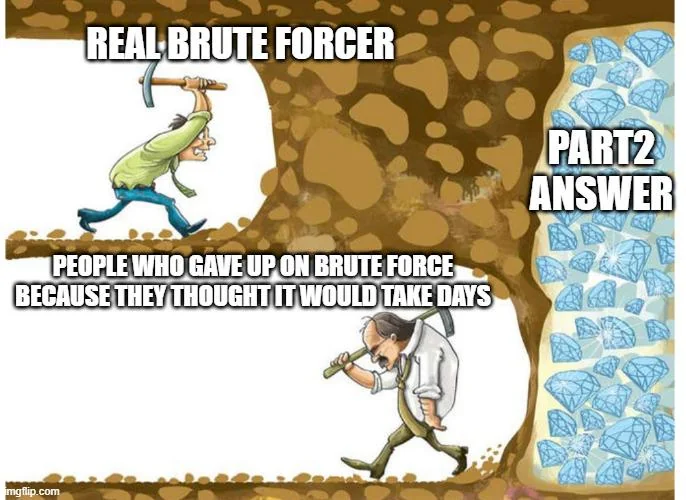The 3-bit Problem

What a tricky day this was!
It took me a long time to figure out the strategy to solve part 2, and most likely without the tips found on the Reddit thread I would never have managed it on my own.
But as usual, let's go through part 1 first: the input consists of a set of registers with their initial values, and a program of comma-separated instructions, each representing a 3-bit digit (so with values of 0 through 7):
Register A: 2024
Register B: 0
Register C: 0
Program: 0,3,5,4,3,0
The program itself is an alternation of opcodes and operands. I'm not going to bore you explaining all the logic in the task - long story short, each instruction manipulates the registers or produces output based on specific rules (mainly division, bitwise XOR, pointer manipulation, etc.). Given the initial register values and a program, we execute the program and collect the output from out instructions (which is opcode # 5). Finally, we join the output values with commas to produce the final result.
Adding everything together, my function looked like this:
function runProgram(computer: Computer) {
let regA = computer.regA ?? 0n;
let regB = computer.regB ?? 0n;
let regC = computer.regC ?? 0n;
const program = computer.program.split(',').map((s) => BigInt(s));
let output = '';
const getCombo = (operand: bigint): bigint => {
switch (operand) {
case 0n:
case 1n:
case 2n:
case 3n:
return operand;
case 4n:
return regA;
case 5n:
return regB;
case 6n:
return regC;
case 7n:
throw new Error('Invalid operand: 7');
default:
throw new Error(`Unknown operand: ${operand}`);
}
};
let pointer = 0;
while (pointer < program.length) {
const opCode = program[pointer];
const operand = program[pointer + 1];
switch (opCode) {
case 0n:
regA = adv(regA, powerOfTwo(getCombo(operand)));
break;
case 1n:
regB = bxl(regB, operand);
break;
case 2n:
regB = bst(getCombo(operand));
break;
case 3n:
if (regA !== 0n) {
pointer = Number(operand);
continue;
}
break;
case 4n:
regB = bxc(regB, regC);
break;
case 5n:
output += out(getCombo(operand)) + ',';
break;
case 6n:
regB = bdv(regA, powerOfTwo(getCombo(operand)));
break;
case 7n:
regC = cdv(regA, powerOfTwo(getCombo(operand)!));
break;
default:
throw new Error(`unknown opcode ${opCode}`);
}
pointer += 2;
}
return output.slice(0, -1); // rm trailing comma
}
If part 1 was rather easy - suspiciously easy for a Day 17 challenge 🤔 - part 2 was… uhm… tricky to say the least.
The goal was now to find the minimum value to assign to register A so that the program's final output is a copy of the program itself.
As you can imagine, it's probably not the kind of program that can be brute-forced by trying all the possible value until we find the correct one… let's just say my answer was 265652340990875 - a number I won't even try to pronounce. So yeah, gotta be smart about it and find a way to solve this before all my hair turns white.
So, after analysing what our program actually does, as I mentioned with a bit of help from the smart AoC crowd on Reddit, a few things become clear:
- Register A is processed in octals, meaning its value is grouped and operated on in chunks of 3 bits.
- Registers B and C are temporary and only hold intermediate results for processing A. They do not retain their values between octal blocks.
- The processing of each octal block depends only on the more significant bits of A, making it easier to replicate the output program by analyzing it in reverse.
- A greedy approach will not work, as there are potential dead ends in the search for valid values of A. To handle this, a depth-first search approach can be used to explore possibilities and backtrack when encountering a dead end.
Translating this into code, my solution looked like this:
function calcMinRegA(computer: Computer) {
const program = computer.program.split(',').map((num) => BigInt(num));
// Recursive function to find the smallest value of reg A for a given position in the program
const findRegA = (value: bigint, current: number): bigint => {
// If all outputs have been validated, return the current value
if (current < 0) return value;
// Iterate over the next 8 possible values of regA for the current octal block
for (let i = value << 3n; i < (value << 3n) + 8n; i++) {
// Simulate the program with the current regA value
const output = runProgram({
regA: i,
regB: 0n,
regC: 0n,
program: computer.program,
})
.split(',')
.map((s) => BigInt(s));
// Check if the program output matches the expected value at the current position
if (output[0] === program[current]) {
// Recursively validate the next position in reverse
const finalVal = findRegA(i, current - 1);
if (finalVal !== -1n) return finalVal; // Return if a valid value is found
}
}
// If no valid value is found for the current octal block, return -1n to backtrack
return -1n;
};
// Start the search with `regA = 0n` and begin validation from the last program position
return findRegA(0n, program.length - 1);
}
So here we are, probably the most deserved star so far 💫